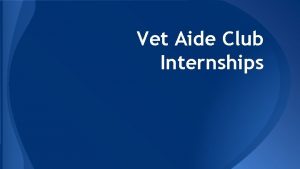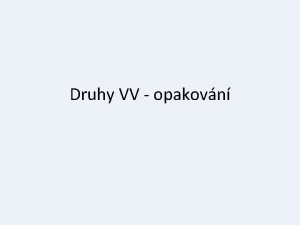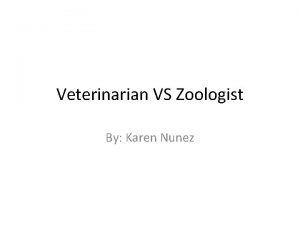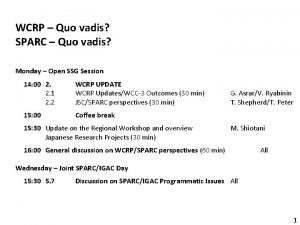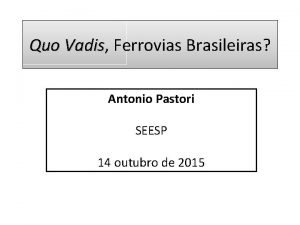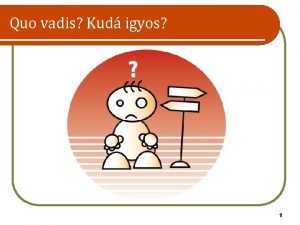Quo vadis with VET or what can we

















- Slides: 17

Quo vadis with VET or what can we learn from each other in Europe

Content of the presentation • A very short outline of the history of Europan VET • Different systems and their background • VET and youth employment • Returns on investment • Some messages from the Q-placement project

Copenhagen 2002: building a true European market requires transnational recognition of VETqualifications Several angles to subdivide systems: • Work based vs school based systems • Employability oriented or job oriented • Comprehensive systems vs market systems • Employer led or government led • Centralised or decentralised • others

Comprehensive systems (1) vs. Market systems (2) Group 1: D, AT, CH, DK. also F, B, NL, Fin • Broader orientation, based on a tightly regulated, but -among stakeholders- negotiated system. • ‘Berufliche Bildung’ (personal/professional development) Group 2: UK, USA (smaller group, winning ground) • Modularised system based on rather narrowly described set of skills. Employer led system. • Market of providers and qualifications (pick & mix)

Lost in translation • EU realised differences; Learning outcomes as a concept to reach common ground • EU has adopted the Anglo-Saxon terms without realising, that there is a whole world behind certain words • Skills is not the same as Fertigkeiten. • Little attention for underpinning knowledge (gr 2) vs. more attention for that (gr 1). • EU has adopted the poorest language, leading to endless semantic discussions with mainly German speaking countries

Germany, Austria and Switzerland • Based on Humboldt’s notion of Allgemeine Menschenbildung • Dual system is based on the ideas of Kerchensteiner (19 th Century) • A way of Emancipation of the working class • Creating a group between the rich and the poor masses • Legacy is still to be found in the German, Austrian, Swiss and Danish system

Germany and Switzerland • • Predominantly dual learning (high status) Access to the dual system is up to employers Low youth unemployment D: Reluctant towards modularisation as a result of the ‘Bildungs’ ideal and strong role of trade unions (lack of flexibility) • CH: High permeability in a very flexible system • CH: Dual learning is other road to the top (VETPET) • High quality of well trained tutors on the job floor

France took another road • Academic knowledge prevails above other forms of knowledge (Ancien Régime, Enlightment) • VET also theoretical, which explains preference for school based learning • Apprenticeships are growing • Interesting development: Lycée des Métiers • Centralised system, part of national structure • Rather weak permeability to HE, as Lycée professionelle is a negative choice

United Kingdom (England) • Community Colleges or FE Colleges • No holistic approach, but fragmentation • External examinations through awarding bodies • System echoes the thoughts of Adam Smith • UK Quote: Successive policy initiatives over several decades have failed to resolve the issue of an effective vocational track, so that we are left with an alphabet soup of qualifications of different sizes, at different levels, with few clear progression routes between them.

The Netherlands • Features of the system are in between the German and the UK system • System of high mutual trust and involvement of social partners, providers and government • Most differentiated system in the world • Two learning pathways, one qualification structure. Communicating vessels (examples) • Dominance of school based learning, but with WBL features • Competence based, but with attention for generic skills and citizenship • Permeability

Take the best out of different systems • CH, D and AT have employer led systems, but nevertheless not narrowly job orientated • Dutch system is based on equal involvement of social partners and providers • Dual system depends on willingness of employers. Dutch system offers strong answer. • Quality of tutors in Swiss companies gives a strong boost to the quality of the dual system • Permeabilty and dual learning opportunities on all levels are very strong points in Switzerland

WBL systems in D, AT, CH, DK and NL have relatively low youth unemployment

Two emerging messages – For high quality apprenticeship, it is crucial to know the duties and assignments of all stakeholders, i. e. school, student and company, during each of the three stages: before, during and after the apprenticeship. – WBL is not a panacea against youth unemployment. However, a high quality apprenticeship in environments where the employee training is a set priority for the company and where employers believe that education meets the economic needs, facilitates the transition to the labour market and reduces youth unemployment.

Returns on investment for employers • Very few research about this topic • Only Switzerland, where the Ro. I is positive • Barriers/Complaints: - time consuming - young people with wrong attitude and few skills - legislation, salaries, other restrictions (examples) • Positive/ profit side - best way for recruitment - apprentices become productive halfway - contributing to qualified working force - taking your responsability

Messages from the project • Both parties; schools and companies stress importance of regular contact, communication • Lack of time to select companies and to visit the pupils is a main problem for schools • Incentives (tax reduction) might be helpful to engage more companies but there is a risk to evoke wrong incentives • importance of attuning the school programs with the company needs is rated very high • Several placements instead of one might be positive for employability on the long term, not on the short.

Final message In order to bring all involved parties together for a better understanding of each others positions, you need to create/organize the necessary structures.

Thank you very much for your attention Manfred Polzin Senior Policy Advisor International Relations MBO Raad; Netherlands Association of VET Colleges m. polzin@mboraad. nl
 Vet to vet
Vet to vet Noblici
Noblici Willa petroniusza opis
Willa petroniusza opis Quo vadis postacie
Quo vadis postacie Lukan quo vadis
Lukan quo vadis Pałac nerona
Pałac nerona Quo vadis filmweb
Quo vadis filmweb Rzym po pożarze quo vadis
Rzym po pożarze quo vadis Autentyzm przestrzeni kamienie na szaniec
Autentyzm przestrzeni kamienie na szaniec Wyzwolenica nerona
Wyzwolenica nerona Pros and cons of being a veterinary technician
Pros and cons of being a veterinary technician Queensland veterinary board
Queensland veterinary board Vet aide club
Vet aide club Vv druhy
Vv druhy Tyska dativ prepositioner
Tyska dativ prepositioner Structuurformule propaanzuur
Structuurformule propaanzuur Dr tasneem vet
Dr tasneem vet Veterinarian vs zoologist
Veterinarian vs zoologist












